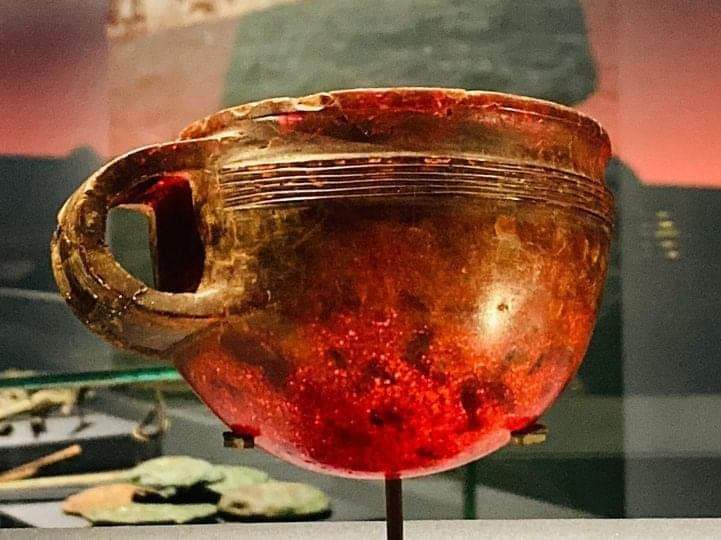3270-year-old Amber cup discovered in a great round barrow mound that was crudely and poorly excavated in 1856 in Hove, UK
The Hove amber cup is a Bronze Age cup that was discovered in a great round barrow mound that was crudely excavated in 1856, in Hove, East Sussex, England, and is now in Hove Museum and Art Gallery.[1] It was found during the construction of Palmeira Square. The barrow was of exceptional size and quality, suggesting a date in the mid-Bronze Age. The Hove amber cup is one of only two found in Britain; the other was in Dorset. However, the two are not of the same style of craftsmanship.

Dated to c. 1750-1550 BCE,[2] the amber cup was found in a Wessex culture grave in a coffin made from a treetrunk. Also in the coffin were a skeleton, a Camerton (Wessex culture) type dagger, a whetstone and a small axe.[3]
It has been associated with a small group of other “unstable” cups with round bottoms, made of precious materials and found in north-western Europe. Most are in gold, but also silver, amber and shale. The Ringlemere Cup and Rillaton Cup are the two British gold cups. The amber would have come from the Baltic region, and the group suggest early trade links between Britain and Europe.[4]

Construction[edit]
The cup is made from a single piece of amber, and this suggests trading links between this part of Britain and the Baltic regions where such amber was extracted.[5]
According to the original description by Barclay Philips,
In the earth with which the coffin was filled were numerous small fragments of carious bone, apparently charred, some of which were picked out; and about the centre, as if, said one of the men, they had rested on the breast of the body interred, were found the following curious relics: —
An Amber Cup, hemispherical in shape, rather deep in proportion to its width, with a “lip” or “nick,” and ornamented merely with a band of fine lines running round the outside, about half an inch from the top. There is one handle, large enough for the insertion of a finger, ornamented with a fillet on each side of the surface, which is flat, similar to that on the cup itself. From the fact of the rim not being perfectly round, and the band before mentioned not passing over the space within the handle, and its being marked off with a line at each end, seemingly cut across, we may conjecture it to have been made and carved by hand. There are two small chips in the rim.

That on the left of the handle is fresh, and was caused by the man who found the cup accidentally striking it, as he told me, with his spade, when he first came upon it; that on the right is not so large, but is ancient, as is shown by its appearance. The cup is perfectly smooth inside and out, excepting where the earth in which it was buried still adheres to the surface; but since its exhumation the amber has cracked slightly in every part. On the cup being lifted by the handle, this broke into two pieces, having received a blow from the workman’s spade, but fortunately the fragments fit very exactly, and I have therefore easily repaired it.
Related Post
A shocking documentary proves that mermaids do exist
SHOCKING Revelation: Thuya, Mother of Queen Tiye, Was the Grandmother of Akhenaten and Tutankhamun—What Ancient Egyptian Secrets Did She Leave Behind?
Breaking News: Astonishing Discoveries at Karahan Tepe Confirm an Extraterrestrial Civilization is Hiding on Earth, and NO ONE Knows!
Breaking News: Researchers FINALLY Discover U.S. Navy Flight 19 After 75 Years Lost in the Bermuda Triangle!
NASA’s Secret Investigation: Uncovering the Astonishing Mystery of the UFO Crash on the Mountain!
Explosive UFO Docs LEAKED: Startling Proof That Aliens Ruled Ancient Egypt!